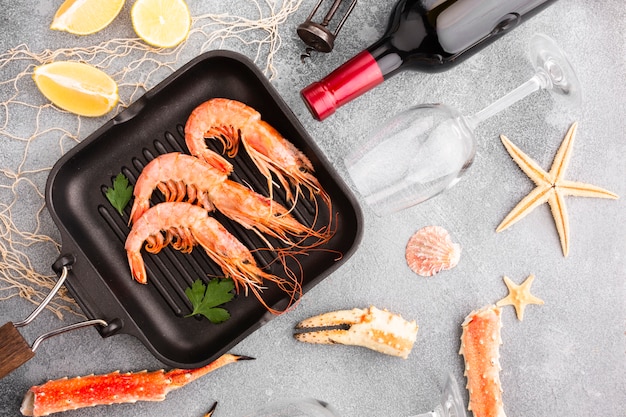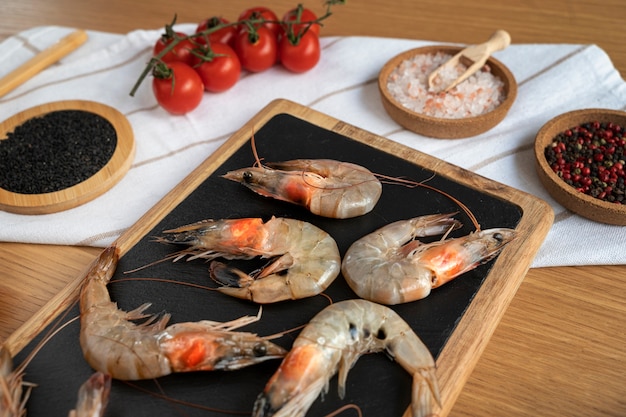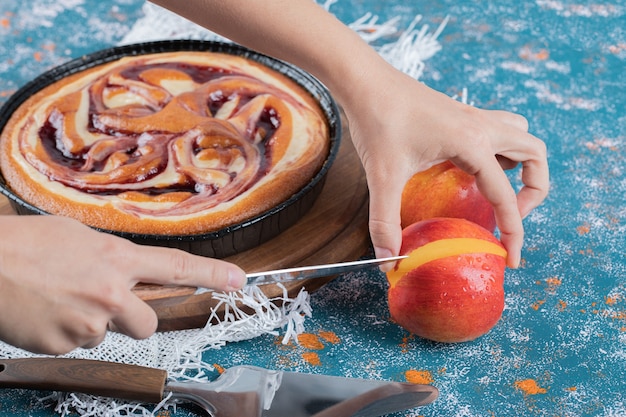Shrimp. Ah, shrimp! The mere mention of these delicate crustaceans sends my taste buds into a frenzy. They're so versatile, so flavourful, and such a delight to cook with. Whether I'm whipping up a quick weeknight pasta dish or grilling them for a summer barbecue, shrimp always deliver. But let's face it, cooking shrimp can be a little nerve-wracking. One minute they're perfectly pink and juicy, and the next they're tough and rubbery. I've definitely made my fair share of shrimp-cooking blunders over the years, but I've learned a thing or two along the way. So, if you're looking to master the art of shrimp cooking, you've come to the right place!This guide is your one-stop shop for everything you need to know about cooking shrimp to perfection. We'll be diving into the different types of shrimp, how to prep them for cooking, and most importantly, how long to cook them using various methods. I'll be sharing my personal tips and tricks, along with some handy tables and frequently asked questions. So, grab a glass of your favourite beverage, get comfy, and let's get cooking!
(Part 1) Understanding Your Shrimp: A Guide to Variety and Size

Demystifying shrimp varieties: From Whiteleg to King Prawn
Firstly, let's talk about the different types of shrimp you're likely to encounter in the UK. The world of shrimp can seem a little overwhelming, but fear not! It's all about knowing your options.
- Whiteleg Shrimp: This is a common and popular choice, often farmed and known for its mild, sweet flavour. It's a great all-rounder and perfect for a variety of dishes.
- Tiger Shrimp: With their distinctive stripes, tiger shrimp are a little more luxurious, offering a bolder flavour and a slightly firmer texture than their whiteleg counterparts. They're a fantastic choice for grilling or adding a touch of elegance to your meals.
- King Prawns: These are the big boys of the shrimp world, boasting a delicate flavour and a wonderfully firm texture. They're perfect for grilling or featuring prominently in your favourite seafood dishes.
- Langoustines: Often called Dublin Bay prawns, these are smaller and sweeter than King prawns. They're a fantastic choice for appetizers, salads, and anything where a smaller, more delicate shrimp is required.
Size Matters: How shrimp sizes Affect cooking times
Did you know that shrimp are graded based on their size? The number of shrimp per pound tells you how large or small they are, with a lower number indicating larger shrimp. This is important because the cooking time can vary significantly depending on the size of the shrimp. Here's a breakdown of the common sizes:
| Size | Shrimp per Pound | Typical Uses |
|---|---|---|
| Jumbo | 10-15 | Grilling, broiling, skewers, feature dishes |
| Large | 16-20 | Stir-fries, pasta dishes, scampi, versatile |
| Medium | 21-25 | Stews, soups, salads, mixed dishes |
| Small | 26-30 | Cocktail shrimp, appetizers, small bites |
Fresh or Frozen: Making the Right Choice
Choosing between fresh and frozen shrimp is a matter of personal preference and availability. fresh shrimp are undoubtedly a treat, especially if you can find them from a reputable fishmonger. They tend to have a more delicate flavour and a slightly firmer texture than frozen shrimp. However, frozen shrimp is a super convenient option, readily available in most supermarkets, and often more affordable. Just make sure to thaw them properly before cooking. My personal advice? If you're lucky enough to find fresh shrimp, go for it! But if you're pressed for time or convenience is a priority, frozen shrimp is a great alternative.
(Part 2) Prepping Your Shrimp: From Thawing to Deveining

Thawing Frozen Shrimp with Care
If you're using frozen shrimp, thawing them correctly is crucial for ensuring they retain their moisture and deliciousness. The best method is to transfer them from the freezer to the refrigerator overnight. This gradual thawing allows them to thaw slowly and evenly. If you're in a rush, you can thaw them in cold water for about 30 minutes, but make sure to change the water every 10 minutes to keep it cold. Avoid thawing shrimp at room temperature, as this can promote bacterial growth.
Cleaning and Deveining: The Nitty-Gritty
Whether you're using fresh or frozen shrimp, they often require a bit of cleaning and deveining before cooking. You can buy them pre-cleaned and deveined, but doing it yourself is a simple process. To devein shrimp, simply make a shallow cut along the back of the shrimp and use a small knife or skewer to remove the dark vein. This is optional, but many people find it improves the shrimp's appearance and flavour.
Seasoning for Success: The Art of Enhancing shrimp flavour
The beauty of shrimp lies in its delicate flavour, so keep seasoning simple and let the shrimp shine. A sprinkle of salt and pepper is usually all you need to enhance their natural flavour. However, if you want to add a little extra oomph, you can incorporate other seasonings like garlic powder, paprika, or a squeeze of lemon juice. Just be mindful of not overpowering the delicate shrimp flavour.
(Part 3) Stovetop Wonders: Mastering the Art of Sauteing and Scampi

The Classic Saute: Simple, Speedy, and Delicious
This is my go-to method for quick and easy shrimp cooking. Heat a tablespoon of olive oil in a large skillet over medium heat. Add the shrimp and cook for about 2-3 minutes per side, or until they turn pink and opaque. Don't overcook them, or they'll become tough. For a flavour boost, you can add a few cloves of garlic, chopped onions, or a splash of white wine to the skillet while the shrimp cook. It's a simple yet satisfying way to enjoy shrimp.
shrimp scampi: A Culinary Classic with a Touch of Italian Charm
Oh, shrimp scampi! This classic Italian dish is a favourite in our household. To make shrimp scampi, saute the shrimp in olive oil until they're cooked through. Then, add a mixture of white wine, lemon juice, garlic, and butter to the skillet. Simmer for a few minutes, allowing the sauce to thicken and become luscious. Serve it over your favourite pasta or rice for a truly decadent meal.
(Part 4) Baking to Perfection: Oven-Baked and Foil Packet Delights
Oven-baked shrimp: Effortless Elegance
Baking shrimp is a fantastic option for a hands-off approach. Preheat your oven to 400 degrees Fahrenheit (200 degrees Celsius). Place the shrimp on a baking sheet lined with parchment paper, season them with your favourite seasonings, and pop them in the oven. Bake for 8-10 minutes, or until the shrimp are cooked through. You can even add vegetables like broccoli, asparagus, or bell peppers to the baking sheet for a complete meal.
Shrimp Foil Packets: A culinary adventure in Foil
Shrimp foil packets are a fun and easy way to cook shrimp, creating a delightful little world of flavour within the foil. Simply place the shrimp in a piece of foil, add your favourite vegetables, seasonings, and a splash of liquid (like white wine or lemon juice). Seal the packet tightly and bake in a preheated oven at 400 degrees Fahrenheit (200 degrees Celsius) for 10-12 minutes. The shrimp will steam in their own juices, creating a flavourful and tender dish.
(Part 5) Grilling for That Smoky Goodness: Barbecued Shrimp Bliss
Grilling Shrimp: A Summertime Must
There's nothing quite like the taste of shrimp cooked over a grill, especially during those glorious summer months. Simply thread the shrimp onto skewers, grill them over medium heat for 2-3 minutes per side, or until they're cooked through. You can brush them with a marinade or glaze for extra flavour. My go-to marinade is a simple mixture of olive oil, lemon juice, garlic, and herbs. It's a perfect match for those smoky summer evenings.
Shrimp on the BBQ: Adding Smoky Sweetness
Another fantastic way to add flavour to your grilled shrimp is to use a bbq sauce. There's a wide variety of BBQ sauces available, so you can find one that suits your taste. Simply brush the shrimp with BBQ sauce and grill them for 2-3 minutes per side, or until they're cooked through. The smoky, sweet, and tangy flavour of BBQ sauce is a delicious complement to grilled shrimp.
(Part 6) Stir-Frying for Speed and Flavour: Quick and Easy shrimp dishes
Quick and Easy Stir-Fried Shrimp: A Speedy Feast
Stir-frying is a fantastic method for a quick and delicious shrimp meal. Heat a tablespoon of oil in a wok or large skillet over high heat. Add the shrimp and stir-fry for 1-2 minutes, or until they're cooked through. Then, add your favourite vegetables and seasonings, and continue stir-frying for a few more minutes, until everything is heated through. Serve over rice or noodles for a satisfying and flavourful meal.
(Part 7) Boiling for Simplicity: shrimp boil Bliss
Shrimp Boil: A Classic Coastal Delight
A shrimp boil is a fun and easy way to cook shrimp, perfect for a casual gathering or a seaside picnic. Simply bring a large pot of salted water to a boil. Add the shrimp and cook for 2-3 minutes, or until they turn pink and opaque. Remove the shrimp from the boiling water and serve immediately. You can add other seafood, vegetables, and spices to your shrimp boil for extra flavour, like corn on the cob, potatoes, and Cajun seasoning. It's a truly delicious and satisfying meal.
(Part 8) Cooking Time: The Key to Shrimp Success
How Long to Cook Shrimp: A Quick Reference Guide
Here's a quick reference guide to help you determine the cooking time for shrimp based on the cooking method:
| Cooking Method | Cooking Time |
|---|---|
| Sauteing | 2-3 minutes per side |
| Baking | 8-10 minutes |
| Grilling | 2-3 minutes per side |
| Stir-frying | 1-2 minutes |
| Boiling | 2-3 minutes |
Signs of Perfectly Cooked Shrimp: A Guide to Shrimp Success
Here are some telltale signs that your shrimp are cooked through:
- The shrimp will turn from translucent to opaque, becoming a beautiful pink colour.
- They will be firm to the touch, but not tough.
Overcooked Shrimp: The Enemy to Avoid
Overcooking shrimp is a culinary crime! Overcooked shrimp become tough and rubbery, ruining their delicate texture and flavour. If you're unsure whether your shrimp are cooked through, cut one open and check. The inside should be opaque and white.
(Part 9) Frequently Asked Questions (FAQs)
1. Can I Cook Shrimp with the Shells On?
Absolutely! Cooking shrimp with the shells on can actually enhance their flavour, as the shells help to create a rich broth. Just make sure to remove the shells before serving.
2. Can I Freeze Cooked Shrimp?
Yes, you can freeze cooked shrimp. Simply cool them completely before freezing. To freeze, place them in an airtight container or freezer bag. Frozen cooked shrimp will last for up to 3 months in the freezer. They're a great time-saver for future meals.
3. Can I Reheat Shrimp?
Yes, you can reheat shrimp, but it's best to do so gently. You can reheat them in the microwave, oven, or on the stovetop. If you're reheating shrimp on the stovetop, add a little bit of liquid to prevent them from drying out.
4. How Do I Know When Shrimp Is Bad?
Fresh shrimp should have a mild, sweet smell. If they have a strong, fishy odour, they've gone bad. You should also avoid shrimp that are discoloured or slimy.
5. What's the Best Way to Store Shrimp?
Fresh shrimp should be stored in the refrigerator, wrapped in plastic wrap or a damp paper towel. They will last for 1-2 days in the refrigerator. Frozen shrimp should be stored in the freezer, in an airtight container or freezer bag. They will last for several months in the freezer.
(Part 10) Conclusion: The Perfect Shrimp Every Time
Congratulations! You're now equipped with all the knowledge you need to cook perfect shrimp every time. Remember, understanding your shrimp, prepping them correctly, and knowing the right cooking times are crucial. Now, go forth, experiment, and enjoy the deliciousness of perfectly cooked shrimp! And if you have any further questions, don't hesitate to ask. Happy cooking!
Everyone is watching

How to Cook Frozen Lobster Tails Perfectly: A Step-by-Step Guide
RecipesLobster. Just the word conjures up images of lavish meals, special occasions, and a taste of luxury. But let's...

Pork Fillet Cooking Time: How Long to Cook It Perfectly
RecipesPork fillet, or tenderloin as it's sometimes called, is a real favourite in our house. It's so versatile, and...

Pigs in a Blanket Cooking Time: How Long to Bake for Perfect Results
RecipesAh, pigs in a blanket. Just the name conjures up images of those delightful little parcels of crispy pastry en...

The Ultimate Guide to Cooking Delicious Frankfurters
RecipesLet's face it, we all love a good frankfurter. It's a classic, simple, and always satisfying. But let's be rea...

Wolf Meat Recipes: A Guide to Cooking Wild Game
RecipesLet's be honest, you don't see wolf meat at your local butcher shop every day. It's a bit of a wild card, but ...
